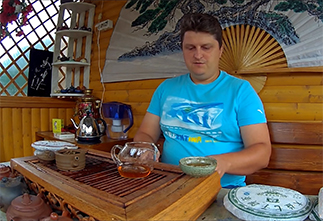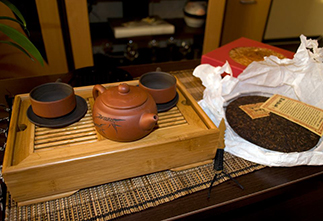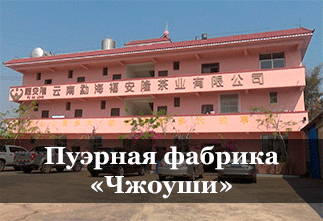The aroma of dry tea leaves is woody, with nuances of forest moss, damp autumn leaves and birch bark.
The taste of brewed tea is soft, without bitterness and astringency, even if you brew it very strongly. It is elusive, as if it is not there, but at the same time, nuances of cocoa, dark chocolate and wooden furniture in an antique shop can be traced.
By the 4th infusion the taste becomes balanced, thick, with notes of ground cocoa. The color of the finished infusion is dark brown, it leaves a true aftertaste, which comes a few minutes after drinking tea, not immediately. It is light, sweetish, enveloping.
For brewing, you can take a little more tea leaves - 10-12 g per teapot made of Yixing clay or a gaiwan with a volume of 150-200 ml. With this ratio, puer can withstand 7 full steeps.
Shu Puer "Nanno" from the Zhoushi factory acts gently, gradually tones and awakens, sobers up, sets the mood for communication, gives lightness and vigor.
This puer is a very suitable option for everyday tea drinking; it is suitable for morning tea, for afternoon tea, and for brewing in a thermos.
|
Name in Chinese
|
南糯山 |
|
Pinyin
|
nánnuòshān |
|
English name
|
“Nanno” of the Zhoushi factory |
|
Translation
|
Mount Nanno |
|
Country
|
China |
|
District
|
Xishuangbanna Dai Autonomous Prefecture |
|
Provinces
|
Yunnan (云南) |
|
Region
|
Menghai (勐海) |
|
Habitat
|
Наньно (南糯, nánnuò) |
|
Manufacturer
|
Чжоуши (周氏) |
|
Raw material production date
|
2008 |
|
Year of pressing
|
2016 |
|
Pressing form
|
Bing Cha (Cake Tea) |
|
Declared weight, g
|
357 |
|
Fermentation method
|
In heaps |
|
Size
|
20x20x2 |
|
Length, cm
|
20 |
|
Width, cm
|
20 |
- Комментарии
- Вконтакте
Pu-erh is one of the most unique types of tea, which only gets better with age. Many people, when they first encounter this tea, wondered: why is pu-erh more often found in pressed form (cakes, bricks, tochas), and not in loose form? The reasons for this are related to both history and the practical aspects of storing and fermenting tea. Despite modern technologies that allow the production of loose pu-erh, the shape of pressed cakes remains unchanged. And pu-erh is more often found on sale in pressed form, for example, in the form of cakes or bricks, and loose pu-erh is less common. We will talk about the reasons for pressing pu-erh into cakes in this article.
Puer is a unique Chinese tea that is distinguished by its depth of taste, complexity of aromas and versatility of aftertaste. Its taste characteristics are formed under the influence of many factors, from growing conditions to the brewing method. Let's look at the main ones.
The question often arises: how to brew puerh correctly? Sometimes the phrase "to get high" is added to it. Moreover, everyone has their own understanding of this phrase. Some mean vigor, and some - intoxication. So how to brew puerh tea correctly? Let's consider several options.
Traveling through the tea mountains, we found ourselves in another land of blue roofs - the village of Zhongcai, which is located in the Menghai district of Yunnan province. According to tradition, we were shown another local tea tree, which, according to the Chinese, is at least a million years old :) The village is very authentic, not designed for tourists, there are many wild pu-erhs there and, of course, we were warmly received. They treated us to local cuisine and tea. We also asked the residents about the prices of tea and how they have changed in recent years.
Well, finally we got to the Zhoushi puer factory, which is located in Menghai, Yunnan Province. We first purchased their cakes remotely several years ago and they were to the taste of Russian tea people. Now it's time to personally meet the owners and expand the range of this brand on the shelves of ChL. In this video, you will see the production process of the already familiar cakes, rare shots of the nuances of packaging and the atmosphere of such places.
The tea ceremony occupies a special place in the centuries-old Eastern tradition. And although the essence of this phenomenon remains constant, the nature and external manifestations of the tea ceremony in different nations have their own national characteristics. In each Chinese province, the tea ceremony and the tea used in it are varied: for example, residents of the southern provinces prefer green tea, and residents of the northern provinces - red tea, in Fujian province they more often use Oolong tea, and in Yunnan province Puer tea is widely known.

























































































